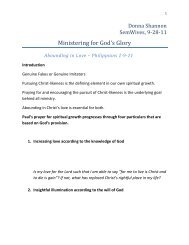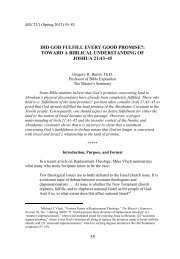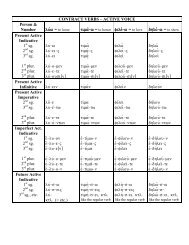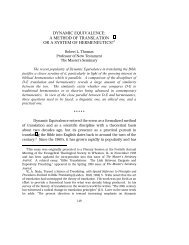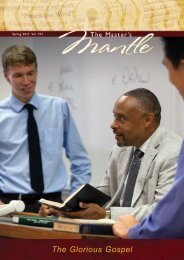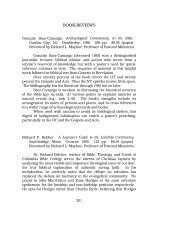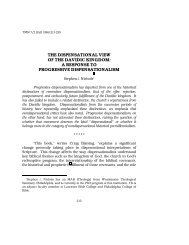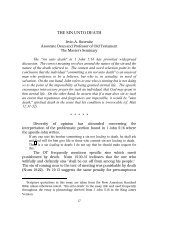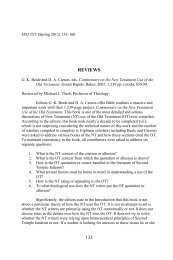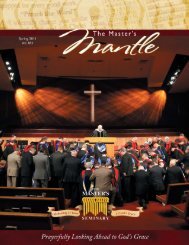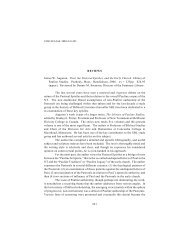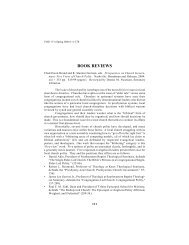Inductive and Deductive Methods as Applied to OT Chronology
Inductive and Deductive Methods as Applied to OT Chronology
Inductive and Deductive Methods as Applied to OT Chronology
You also want an ePaper? Increase the reach of your titles
YUMPU automatically turns print PDFs into web optimized ePapers that Google loves.
104 The M<strong>as</strong>ter’s Seminary Journalinherent in a proper treatment of all the observations just listed <strong>and</strong> their multiplecombinations. The e<strong>as</strong>y way <strong>to</strong> h<strong>and</strong>le this complexity is <strong>to</strong> make simplifying<strong>as</strong>sumptions. Thus the Seder Olam <strong>and</strong> the Talmud <strong>as</strong>sume that all reign lengths areme<strong>as</strong>ured from the start of the king’s sole reign. Gershon Galil made the opposite<strong>as</strong>sumption by presuming that all regnal years when a coregency is involved wereme<strong>as</strong>ured from the start of the coregency. 16 An even greater simplification w<strong>as</strong>invented by Wellhausen, who ruled out coregencies al<strong>to</strong>gether, even the plainlystatedcoregency of David with Solomon. 17 The consequences of this kind ofprocedure are obvious: the scholars who make such simplifying <strong>as</strong>sumptions will notagree with scholars who make other, contradic<strong>to</strong>ry <strong>as</strong>sumptions. The simplificationswill also produce chronologies that contradict scriptural texts at some point oranother; scholars will then, unjustifiably, claim that the Scripture is in error becauseit does not fit their scheme.Successes of the <strong>Inductive</strong> MethodIn contr<strong>as</strong>t, scholars who have used the inductive approach attempt <strong>to</strong> makeno a priori <strong>as</strong>sumptions. Instead, they employ scriptural texts <strong>to</strong> determine themethod used by the ancient authors, taking in<strong>to</strong> account the different archaeological<strong>and</strong> his<strong>to</strong>rical evidences listed above <strong>and</strong> not ruling out any possibility until validre<strong>as</strong>ons for doing so surface. In the 1920s Professor Coucke of the Gr<strong>and</strong> Seminairede Bruges determined from a careful analysis of the data in Kings <strong>and</strong> Chronicles thatJudah began its regnal years in Tishri, where<strong>as</strong> Israel began its regnal years inNisan. 18 He also determined that the reign lengths of the first kings of Judah <strong>and</strong>Israel were in harmony with each other if these first kings in Judah used accessionreckoning while their counterparts in Israel were using non-accession reckoning <strong>to</strong>me<strong>as</strong>ure their years of reign.Some years later an American scholar, Edwin Thiele, discovered the sameprinciples, although when he began publishing his findings, he w<strong>as</strong> not aware ofCoucke’s earlier work. Thiele w<strong>as</strong> able <strong>to</strong> determine the chronology of the kings ofIsrael <strong>and</strong> Judah in a more satisfac<strong>to</strong>ry way than Coucke, <strong>and</strong> his principal work, TheMysterious Numbers of the Hebrew Kings, went through three editions. The16 Gershon Galil, The <strong>Chronology</strong> of the Kings of Israel <strong>and</strong> Judah (Leiden: Brill, 1996) 10.17 Wellhausen w<strong>as</strong> followed in this presupposition by two more recent authors of <strong>OT</strong> chronologicalstudies: Jeremy Hughes, Secrets of the Times: Myth <strong>and</strong> His<strong>to</strong>ry in Biblical <strong>Chronology</strong> (Sheffield:Sheffield Academic, 1990) 99, 103, <strong>and</strong> Tetley, Reconstructed <strong>Chronology</strong> 117. After such rejection ofwell-established practices from the ancient Near E<strong>as</strong>t in order <strong>to</strong> make things simpler, such scholars findit necessary <strong>to</strong> make a plethora of secondary <strong>as</strong>sumptions in order <strong>to</strong> explain the disagreements of theirsystems with the data.18 V. Coucke, “Chronique biblique,” in Supplément au D ictionnaire de la Bible, Louis Pirot ed., vol.1 (1928), cited in Thiele, Mysterious Numbers 59 n. 17.
106 The M<strong>as</strong>ter’s Seminary Journallengths <strong>and</strong> synchronisms of Kings <strong>and</strong> Chronicles, <strong>and</strong> using an exact notation thatindicated whether the years were being me<strong>as</strong>ured according <strong>to</strong> Judah’s Tishri yearsor Israel’s Nisan years, he w<strong>as</strong> able <strong>to</strong> produce a chronology for the dividedmonarchies that w<strong>as</strong> consistent with all the scriptural texts chosen. That w<strong>as</strong> thelogical outgrowth of Thiele’s work, <strong>and</strong> it attained a holy grail that had been soughtfor twenty-two centuries, namely a rational explanation of the chronological data ofthe Hebrew monarchies that w<strong>as</strong> consistent with the scriptural texts used <strong>to</strong> constructthe chronology, <strong>and</strong> also consistent with several fixed dates from Assyrian <strong>and</strong>Babylonian his<strong>to</strong>ry.Significance of the Successes of the <strong>Inductive</strong> MethodThe significance of Thiele’s work <strong>and</strong> its logical extension in McFall’sarticle can hardly be overestimated. One way of emph<strong>as</strong>izing the significance is <strong>to</strong>consider just how improbable such an accomplishment w<strong>as</strong> when starting from thepremises of the critics who were cited earlier in this article. They, <strong>and</strong> many otherswho could be quoted, believed that it w<strong>as</strong> impossible <strong>to</strong> construct a coherent <strong>and</strong>rational chronology from the data given in the received text. The primary re<strong>as</strong>on forthis belief (or unbelief) must have been because they saw little re<strong>as</strong>on <strong>to</strong> pursue allthe hard work that Coucke <strong>and</strong> Thiele had <strong>to</strong> struggle with before they determined themethods of the biblical authors; why spend time trying <strong>to</strong> determine if there w<strong>as</strong> are<strong>as</strong>onable explanation of the texts when they were sure that late-date writers, such<strong>as</strong> they supposed were the authors of the Scripture, could not have produced anaccurate chronology for long-p<strong>as</strong>t events?In this conclusion they were correct, if their starting <strong>as</strong>sumption is granted.If late-date authors <strong>and</strong> edi<strong>to</strong>rs who lived long after the events they were describingput <strong>to</strong>gether the Scriptures, such authors <strong>and</strong> edi<strong>to</strong>rs could not have producedchronological data of the complexity found in Kings, Chronicles, Jeremiah, <strong>and</strong>Ezekiel that harmonize with each other <strong>and</strong> are also consistent with several dates inAssyrian <strong>and</strong> Babylonian his<strong>to</strong>ry. The critics have declared implicitly or explicitlythat these presumed writers could never give a consistent chronology for the kingdomperiod. However, such a chronology h<strong>as</strong> been produced, <strong>and</strong> so the critics haveestablished by their own statements that their initial <strong>as</strong>sumption about the late-dateorigin of the textual sources used in Kings <strong>and</strong> Chronicles w<strong>as</strong> false.Their error can be demonstrated <strong>as</strong> follows. Imagine someone cutting <strong>as</strong>eries of arbitrary shapes out of cardboard—in the present c<strong>as</strong>e, more than 120 suchshapes—<strong>and</strong> then hoping that somehow the shapes would fit <strong>to</strong>gether in a picturepuzzle. Better than the analogy of a picture puzzle is that of a logic puzzle. Figure 1shows a logic puzzle. The example given deals with trying <strong>to</strong> match five professorswith their cl<strong>as</strong>ses <strong>and</strong> their eccentric ide<strong>as</strong>. The clues, given in sentences one throughseven, provide sufficient information <strong>to</strong> solve the puzzle. An instructive exercisewould be <strong>to</strong> try <strong>to</strong> make up clues for this puzzle before determining the answer <strong>to</strong> the
<strong>Inductive</strong> <strong>and</strong> <strong>Deductive</strong> <strong>Methods</strong> <strong>as</strong> <strong>Applied</strong> <strong>to</strong> <strong>OT</strong> <strong>Chronology</strong> 107puzzle. If this is attempted, it will soon be concluded that late-date edi<strong>to</strong>rs cannotinvent clues <strong>and</strong> have them all fit <strong>to</strong>gether; before clues are provided, the answermust be known that will fit <strong>to</strong>gether in<strong>to</strong> a solution. Furthermore a sufficient numberof clues must be given so that someone else can solve the puzzle.Figure 1. Example of a Logic Puzzle 23Amy takes five cl<strong>as</strong>ses (including his<strong>to</strong>ry) at Bimbleman University, each taught by a differentprofessor. At first she w<strong>as</strong> baffled by the fact that each instruc<strong>to</strong>r (including ProfessorBookwerme) h<strong>as</strong> a different eccentric pet theory, but by now she h<strong>as</strong> gotten used <strong>to</strong> theirdigressions. Can you determine each professor’s cl<strong>as</strong>s <strong>and</strong> theory?1. Amy’s psychology professor is not Dr. Weissenhimer.2. Her philosophy cl<strong>as</strong>s meets just after that of the professor who claims that dinosaurs werereally aliens who got stuck here on a field trip.3. Her political science cl<strong>as</strong>s meets just before the cl<strong>as</strong>s with the professor who insists thatShakespeare’s plays were really written by someone named Larry.4. Professor Smartalecq believes that gravity is a hoax perpetrated by the hot-air balloonindustry; Professor Noetalle does not teach his<strong>to</strong>ry.5. Amy’s psychology professor firmly believes that the lunar l<strong>and</strong>ing w<strong>as</strong> faked on a NorthDakota prairie.6. As one professor orated about dinosaurs, Amy slipped out <strong>to</strong> attend her next cl<strong>as</strong>s, led byDr. Eguehedd.7. The his<strong>to</strong>ry professor, who isn’t Dr. Weissenhimer, believes that the earth is flat.23 Puzzle is from Scott McKinney, “Academia Nuts,” in Dell Logic Puzzles (Norwalk, Conn.: DellMagazines, Dec. 2001):10. Copyright © 2006, Dell Magazines. Dell Logic Puzzles, December 2001.Used with permission of the publisher. All rights reserved. Visit Online at www.dellmagazines.com(accessed 12/30/06) for more favorite puzzles.
110 The M<strong>as</strong>ter’s Seminary JournalHere then is a great mystery: the Author of the chronological puzzle inKings <strong>and</strong> Chronicles knew the answer, <strong>and</strong> He w<strong>as</strong> careful <strong>to</strong> provide enough cluesso that an answer could be found after suitable mental exercise. The chronologicaltexts of the kingdom period are revealed <strong>as</strong> an example of something quite awesome:purposeful design. In other words, Intelligent Design. No other way exists <strong>to</strong> explainhow all the texts can fit <strong>to</strong>gether, <strong>and</strong> how a sufficient number of clues h<strong>as</strong> been givenso that the chronology can be solved without having <strong>to</strong> resort <strong>to</strong> the arbitrary<strong>as</strong>sumptions of the deductive method. But just <strong>as</strong> opponents of Intelligent Designgr<strong>as</strong>p at straws with a sort of blind faith that their own presuppositions must be right,so practitioners of the deductive method will never see the design inherent in thechronological texts of the kingdom period unless they give up their wrong approach<strong>and</strong> their wrong presuppositions regarding the origin of the text.Some Refinements <strong>to</strong> the Thiele/McFall SystemIn speaking of the Thiele/McFall chronological system, the discussion abovestated that it w<strong>as</strong> consistent with all the texts that McFall used <strong>to</strong> build his chronology.However, McFall did not use some texts out of the approximately 124 of anexact nature that are the clues for this period. My own efforts were directed <strong>to</strong>wardexamining all these texts <strong>and</strong> making it the first priority <strong>to</strong> determine the methods ofthe authors of Scripture. In order <strong>to</strong> manage all the data <strong>and</strong> their possible combinationswithout making a priori <strong>as</strong>sumptions, introducing the method of DecisionTables that I had used in my work <strong>as</strong> a systems analyst w<strong>as</strong> necessary. DecisionTables had proved invaluable in h<strong>and</strong>ling the complexities of the l<strong>as</strong>t major systemthat I designed at IBM. Fresh from this experience, I saw that Decision Tables couldbe used <strong>to</strong> explore all the combinations of the chronological parameters that werepresented earlier in this paper. Decision Tables allow the exploring of all possibilitiesthat are consistent with the investiga<strong>to</strong>r’s b<strong>as</strong>ic <strong>as</strong>sumptions, <strong>and</strong> they show whichcombinations of those <strong>as</strong>sumptions are not compatible with the data. The “data,” inthis c<strong>as</strong>e, are the texts being studied <strong>and</strong> fixed dates from Assyrian <strong>and</strong> Babylonianhis<strong>to</strong>ry. The method of Decision Tables is entirely logical, <strong>and</strong>, if used properly,entirely impartial; it provides the final step that is needed in the inductive methodologyfor examining these chronological texts.The first contribution of using Decision Tables w<strong>as</strong> a resolution of somediscrepancies in Thiele’s figures for the regnal years of Jehoshaphat, Ahaziah, <strong>and</strong>Athaliah. 25 The second contribution dealt with the end of the monarchic period,utilizing texts in Ezekiel that were not used by McFall in building his chronology.Ezekiel’s texts show that non-accession years are <strong>to</strong> be used for Zedekiah, contrary<strong>to</strong> the <strong>as</strong>sumption of Thiele <strong>and</strong> McFall that Zedekiah’s years are given by accession25 Young, “Solomon” 598-99; Rodger Young, “When W<strong>as</strong> Samaria Captured? The Need forPrecision in Biblical Chronologies,” JETS 47 (2004):578-79.
112 The M<strong>as</strong>ter’s Seminary Journala proper methodology <strong>to</strong> h<strong>and</strong>le all these data include the use of Decision Tables inorder <strong>to</strong> eliminate wrong <strong>as</strong>sumptions <strong>and</strong> <strong>to</strong> show all the possibilities that must beexplored before the best solution can be determined?The same questions regarding methodology could be <strong>as</strong>ked of any nontriviallogic puzzle. It would be very difficult <strong>to</strong> solve the logic puzzle of Figure 1without first learning how <strong>to</strong> use the grid that is included below the puzzle. Allpuzzle-solvers learn <strong>to</strong> use these grids. They are really Decision Tables. If DecisionTables are necessary <strong>to</strong> solve logic puzzles, how can the complicated chronologicaldata of Jeremiah, Ezekiel, Kings, <strong>and</strong> Chronicles be h<strong>and</strong>led without making use ofa similar logical method?This does not answer the question of why the data are so complex that it isnecessary <strong>to</strong> be very careful <strong>to</strong> use a logical methodology that includes DecisionTables in order <strong>to</strong> h<strong>and</strong>le them <strong>and</strong> <strong>to</strong> show which combinations are fe<strong>as</strong>ible <strong>and</strong>which produce contradictions. One might <strong>as</strong> well <strong>as</strong>k why it is necessary <strong>to</strong> m<strong>as</strong>terthe methods of calculus <strong>to</strong> gain even a preliminary underst<strong>and</strong>ing of the motions ofthe planets, <strong>and</strong> beyond that <strong>to</strong> m<strong>as</strong>ter both Special <strong>and</strong> General Relativity if moreexact refinements in planetary <strong>and</strong> satellite motion are <strong>to</strong> be h<strong>and</strong>led. Does anyonesay that these laws are not valid, just because it takes effort <strong>and</strong> discipline <strong>to</strong>underst<strong>and</strong> them? Perhaps in matters of chronology, one would have liked theScriptures <strong>to</strong> be e<strong>as</strong>ier <strong>to</strong> underst<strong>and</strong>, so that there would not have been so manyinterpreters declaring that the Scripture is in error simply because the interpreterswere incompetent in determining the methods of the authors of Scripture. In mattersessential <strong>to</strong> salvation, the Scriptures are plain enough that a wayfaring man, thougha fool, need not err therein. But in other are<strong>as</strong> such <strong>as</strong> the one presently underdiscussion, God’s ways are not our ways, <strong>and</strong> His thoughts are higher than ourthoughts. It w<strong>as</strong> not in the Holy Spirit’s design <strong>to</strong> make all portions of Scripture e<strong>as</strong>y<strong>to</strong> underst<strong>and</strong>. It w<strong>as</strong> in His design <strong>to</strong> make all Scripture so it is without error.Successes of the <strong>Inductive</strong> Method with Respect <strong>to</strong> External DatesIn a 1996 article, Kenneth Str<strong>and</strong> wrote, “What h<strong>as</strong> generally not been givendue notice is the effect that Thiele’s clarification of the Hebrew chronology of thisperiod of his<strong>to</strong>ry h<strong>as</strong> had in furnishing a corrective for various dates in ancientAssyrian <strong>and</strong> Babylonian his<strong>to</strong>ry.” 28 The purpose of Str<strong>and</strong>’s article w<strong>as</strong> <strong>to</strong> show thatThiele’s methodology accomplished more than just producing a coherent chronologyfrom scriptural data. His chronology, once produced, proved useful in settling sometroublesome problems in Assyrian <strong>and</strong> Babylonian his<strong>to</strong>ry. As Str<strong>and</strong> pointed out,this outcome w<strong>as</strong> quite the opposite of what some of Thiele’s critics <strong>as</strong>serted, namelythat Thiele merely juggled the scriptural data until he could match generally accepted28 Kenneth A. Str<strong>and</strong>, “Thiele’s Biblical <strong>Chronology</strong> As a Corrective for Extrabiblical Dates,” AUSS34 (1996):295.
<strong>Inductive</strong> <strong>and</strong> <strong>Deductive</strong> <strong>Methods</strong> <strong>as</strong> <strong>Applied</strong> <strong>to</strong> <strong>OT</strong> <strong>Chronology</strong> 113dates from the surrounding nations. 29 In the scientific method, the final stage invalidating a new theory is when the theory is able <strong>to</strong> go beyond the explanation ofalready-observed phenomena <strong>and</strong> predict new phenomena that follow <strong>as</strong> a logicalconsequence if the theory is true. Something very akin <strong>to</strong> this resulted from Thiele’spainstaking work in determining the chronological mechanisms used in Scripture.Str<strong>and</strong>’s article summarized several are<strong>as</strong> in which Thiele’s research, instead ofbending its results <strong>to</strong> fit prevailing opinions in Assyrian <strong>and</strong> Babylonian chronology,provided instead a corrective for such prevailing opinions. In three significant are<strong>as</strong>,the adjustments have been shown <strong>to</strong> be correct when further archaeological data havecome <strong>to</strong> light. Such verifications correspond, in his<strong>to</strong>rical research, <strong>to</strong> the successfulprediction of new phenomena for a theory in the physical sciences. Some are<strong>as</strong> arestill controversial (see below), but the successes that have already been achieved <strong>as</strong>a result of the Thiele/McFall chronology form a chapter in biblical interpretation <strong>and</strong>literary analysis that is perhaps without equal in the his<strong>to</strong>ry of modern biblicalstudies. It would be difficult <strong>to</strong> cite any similar successes from the deductive methodthat forms the b<strong>as</strong>is for much of current biblical criticism.Are These Findings Negated by Any Fixed Near E<strong>as</strong>tern Dates?In the p<strong>as</strong>t, various “fixed dates” have supposedly conflicted with Thiele’schronology, such <strong>as</strong> the date of the Battle of Qarqar, initially wrongly <strong>as</strong>signed <strong>to</strong> 854B.C. Although there is still controversy over some synchronisms <strong>to</strong> surroundingcountries, the credibilities of the remaining challenges <strong>to</strong> the Thiele/McFallchronology suffer, in all but one c<strong>as</strong>e, from a lack of consensus among scholars fora single alternative for the date in question. The exception <strong>to</strong> this is the timingconjectured for Menahem’s tribute <strong>to</strong> Tiglath-Pileser III, mentioned in 2 Kgs 15:19-20 (where Pul = Tiglath-Pileser). The date <strong>as</strong>signed by most Assyriologists <strong>to</strong> thisevent h<strong>as</strong> the advantage of a fair amount of scholarly opinion in its support, withoutthe divergence of ide<strong>as</strong> such <strong>as</strong> are found for other chronological problem are<strong>as</strong>. Theyear for Menahem’s tribute favored by the Assyriologists, 738 B.C., is in conflict withthe Thiele/McFall chronology that places the death of Menahem in the six-monthperiod before Nisan 1 of 741 B.C. This issue h<strong>as</strong> emerged <strong>as</strong> the greatest obstacle <strong>to</strong>many scholars in accepting Thiele’s method <strong>and</strong> chronology. The most extensive29 Another criticism is that Thiele’s <strong>and</strong> McFall’s approach is “<strong>to</strong>o complicated.” See the precedingsection for a consideration of whether this argument is valid. It should also be noted that critics who donot make an effort <strong>to</strong> underst<strong>and</strong> the inductive m ethod end up producing explanations of the scripturaltexts that call for numerous <strong>as</strong>sumptions <strong>and</strong> emendations. When these are all written down the systemis invariably more complicated than the system that h<strong>as</strong> been built on the five starting points of theinductive method that were listed at the beginning of the present article.
114 The M<strong>as</strong>ter’s Seminary Journalmodern analysis of the time of Tiglath-Pileser is that of Hayim Tadmor. 30 Followingis a brief summary of the facts regarding the controversy, <strong>as</strong> derived primarily fromTadmor’s work.1. Tiglath-Pileser’s records state that he received tribute from various western kings whenhe w<strong>as</strong> in the city of Arpad. According <strong>to</strong> Luckenbill’s translation, the only entry in theAssyrian Eponym Chronicle (AEC) that indicated when Tiglath-Pileser w<strong>as</strong> “in Arpad”w<strong>as</strong> the entry for 743 B.C., a date consistent with Thiele’s <strong>and</strong> McFall’s dates for Menahem.The full entry for 743 <strong>as</strong> given by Luckenbill is: “in the city of Arpadda. A m<strong>as</strong>sacre<strong>to</strong>ok place in the l<strong>and</strong> of Urartu.” 31 Tadmor wrote the following regarding Luckenbill’stranslation: “This translation of this crucial line, however, h<strong>as</strong> been disputed by severalscholars. It should most likely be taken <strong>to</strong> mean that the army of Urartu suffered a defeatin (the l<strong>and</strong> of) Arpad, so that the earliest occ<strong>as</strong>ion for the payment of such tribute wouldbe 740, when Arpad fell following a three-year siege.” 32 However, Tadmor’s translationcontradicts the cus<strong>to</strong>mary usage in the AEC of the phr<strong>as</strong>e “in (a place).” This normallymeans that the reigning king of Assyria w<strong>as</strong> in that place. Furthermore, the determinativefor Arpad is uru, meaning a city, not the determinative for a l<strong>and</strong>. It is also difficult <strong>to</strong>accept that Urartu (Ararat/Armenia) w<strong>as</strong> defeated in the city, consistent with the rest ofTadmor’s translation. For all these re<strong>as</strong>ons, Luckenbill’s translation is <strong>to</strong> be preferred, <strong>and</strong>that translation is consistent with Menahem’s tribute being delivered when Tiglath-Pileserw<strong>as</strong> “in Arpad,” in 743 B.C.2. The main re<strong>as</strong>on that Tadmor <strong>and</strong> other Assyriologists <strong>as</strong>sign Menahem’s tribute <strong>to</strong> 738is because an inscription from late in Tiglath-Pileser’s reign gave a list of tributary kings,including Menahem, just before an entry describing events in the Assyrian monarch’sninth year, 737 B.C. The <strong>as</strong>sumption w<strong>as</strong> made that the tribute from the kings w<strong>as</strong> allgiven in the preceding year. But this would not necessarily follow if the tribute list w<strong>as</strong>a summary list. Summary lists were very common in Assyria <strong>and</strong> elsewhere in the ancientNear E<strong>as</strong>t. They lump <strong>to</strong>gether all the kings giving tribute or all the geographical regionsconquered, irrespective of the year in which the tribute w<strong>as</strong> given or the region conquered.Thiele expected that Tadmor’s publication of the Iran Stele, which contains the earlies<strong>to</strong>f all extant Assyrian records mentioning Menahem’s tribute, would show that the tributelist in the later Assyrian records w<strong>as</strong> a summary list. 33 Thiele died in 1986 <strong>and</strong> Tadmordid not publish his translation of the Iran Stele until his book on Tiglath-Pileser appearedin 1994. In that publication it w<strong>as</strong> shown that the tribute list of the Iran Stele w<strong>as</strong>definitely a summary list. The implication is that the later list, the list from whichAssyriologists make the inference that the tribute w<strong>as</strong> in 738, w<strong>as</strong> also a summary list,copied either from the Iran Stele or from an earlier pro<strong>to</strong>type from which both lists werecopied. The Iran Stele therefore vindicated Thiele by its evidence that the tribute listscontaining the name of Menahem are summary lists, so that, b<strong>as</strong>ed only on the30 Hayim Tadmor, The Inscriptions of Tiglath-Pileser III, King of Assyria (Jerusalem : IsraelAcadem y of Sciences <strong>and</strong> Humanities, 1994).31 ARAB 2.436.32 Tadmor, Inscriptions 268.33 Thiele, Mysterious Numbers 162.
<strong>Inductive</strong> <strong>and</strong> <strong>Deductive</strong> <strong>Methods</strong> <strong>as</strong> <strong>Applied</strong> <strong>to</strong> <strong>OT</strong> <strong>Chronology</strong> 115consideration of the tribute lists without regard <strong>to</strong> the other evidence, the tribute couldhave been given at any time from the first year of Tiglath-Pileser, 745 B.C., until the yearbefore the Iran Stele w<strong>as</strong> erected in 737 B.C.3. The list that mentioned Menahem’s name in the Iran Stele also mentioned tribute fromTuba’il (=Ithobaal II), king of Tyre. Tadmor cited Annal 27 of Tiglath-Pileser <strong>as</strong> showingthat Hiram, who succeeded Ithobaal, w<strong>as</strong> on the throne of Tyre in 738 B.C. 34 This impliesthat the tribute from Tyre, <strong>and</strong> probably from Menahem also, w<strong>as</strong> earlier than 738. Inorder <strong>to</strong> explain this, Tadmor conjectured that Menahem gave tribute twice, once in 738<strong>and</strong> “once in 740 or even earlier.” 35 A simpler interpretation is that there w<strong>as</strong> only onetribute, in the “or even earlier” year of 743 B.C.The question of the date of Menahem’s tribute <strong>to</strong> Tiglath-Pileser deservesa fuller treatment than h<strong>as</strong> been given here. Devoting these few paragraphs <strong>to</strong> theissue, however, shows that the 738 date for the tribute, which is the most serious ofall the objections <strong>to</strong> the Thiele/McFall chronology, is built on a series of <strong>as</strong>sumptionsthat are quite ad hoc. The relevant data from the Assyrian texts support a date of 743for Menahem’s tribute, a year during which Ithobaal II w<strong>as</strong> on the throne of Tyre,Menahem w<strong>as</strong> king in Samaria, <strong>and</strong> Tiglath-Pileser w<strong>as</strong> in the city of Arpad <strong>to</strong>receive tribute from these kings. The date of 743 is also consistent with the biblicaltexts for this period <strong>and</strong> the Thiele/McFall chronology built on those texts.ConclusionThe above study h<strong>as</strong> compared the deductive <strong>and</strong> inductive approaches <strong>to</strong>studying the chronology of the divided kingdoms. The inductive approach h<strong>as</strong> beendescribed in detail. The study h<strong>as</strong> shown it <strong>to</strong> be entirely logical, in contr<strong>as</strong>t <strong>to</strong> thedeductive method that makes unjustified simplifications <strong>and</strong> then rejects data that donot fit those simplifications. Because the deductive method is limited <strong>and</strong> unsuitablefor this kind of investigation, scholars who have used this method have produced ahost of differing chronologies for which no consensus h<strong>as</strong> ever been reached. Incontr<strong>as</strong>t, scholars such <strong>as</strong> Coucke, Thiele, Horn, <strong>and</strong> McFall started from observedpractices of the court recorders in the ancient Near E<strong>as</strong>t. As an outcome of theirinductive method, a chronology giving exact data <strong>and</strong> in harmony with all the biblicaltexts h<strong>as</strong> been achieved for the kings of Israel <strong>and</strong> Judah. The chronology is alsoconsistent with several fixed dates in Assyrian <strong>and</strong> Babylonian his<strong>to</strong>ry. The study h<strong>as</strong>examined in detail the contention of critics that the chronology w<strong>as</strong> accomplished bya clever juggling of the data. To counteract that criticism, a comparison h<strong>as</strong> beenmade with a logic puzzle. If someone designing a logic puzzle cannot formulateconsistent clues for the puzzle without first setting forth the puzzle’s solution, neithercould modern scholars have developed a consistent chronological structure from the34 Tadmor, Inscriptions 266-67.35 Ibid., 276.
116 The M<strong>as</strong>ter’s Seminary Journalfour centuries of data found in six major books of the Bible. The complexities of 124exact synchronisms, reign lengths, <strong>and</strong> dates in 1 <strong>and</strong> 2 Kings, 1 <strong>and</strong> 2 Chronicles,Jeremiah, <strong>and</strong> Ezekiel negate that possibility unless the data were his<strong>to</strong>ricallyauthentic. Neither would it have been possible for the final edi<strong>to</strong>rs who penned thebooks of Kings <strong>and</strong> Chronicles <strong>to</strong> produce the harmony found in those texts unlesstheir sources related an accurate his<strong>to</strong>ry of the times, exact in the minutest details ofchronology.



